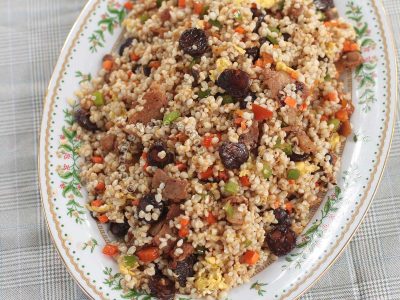If you think that authentic miso soup should have only three solid ingredients — tofu, wakame and scallions — you might be in for a surprise. There are so many other ingredients that can be added to miso soup. Tofu is not even always a must.
Miso soup with pork and vegetables is either tonjiru (its name in Eastern Japan) of butajiru (the name it goes by in Hokkaido and Western Japan. Why the two names? It’s a translation thing. There is only one character in the Japanese writing system and that character can be pronounced either as “buta” or “ton”. See below two Japanese pork dishes and notice their names.
Japanese braised pork belly (buta no kakuni)
To cook buta no kakuni, chunks of pork belly are browned then braised in soy sauce, mirin, dashi, ginger and sugar until the fat literally melts in the mouth.
Tonkatsu
It’s Japanese fried panko-coated pork cutlet. Golden and ultra crisp, it is served with tonkatsu sauce made with Worcestershire sauce, ketchup, oyster sauce and sugar.
So, tonjiru / butajiru is cooked with pork and a variety of vegetables. There is no hard rules as to what vegetables can accompany the pork. Radish (daikon), carrot, seaweed and scallions are common but starchy vegetables like sweet potatoes can be added too. Mushrooms are often thrown in too.
Pork and vegetables miso soup (tonjiru / butajiru)

Ingredients
- 1 small handful wood ears
- 1 small onion
- 1 half-inch knob ginger
- 300 grams pork belly or shoulder
- 1 tablespoon sesame seed oil
- 6 cups dashi
- ½ cup julienned carrot
- 1 cup green beans or yard-long beans, cut into two-inch lengths
- 2 heaping tablespoons miso paste
- salt
- sliced scallions to garnish
Instructions
- Place the wood ears in a bowl and pour in enough hot water to cover.
- Peel and thinly slice the onion.
- Peel and grate the ginger.
- Thinly slice the pork.
- Heat the sesame seed oil in a pot. Spread the pork slices and cook, stirring occasionally, until lightly browned.
- Add the ginger and onion slices to the pork; continue cooking with occasional stirring until the onion slices are soft.
- Pour the dashi into the pot.
- Simmer the pork for about 20 minutes or until tender.
- Drain the now-swollen wood ears and cut into bite-size pieces.
- Add the wood ears, carrot and beans to the pork. Cover the pot and simmer until the vegetables are done.
- Place the miso paste in a bowl and add a cup of the hot broth. Stir until no lumps remain.
- Pour the diluted miso paste into the pot and stir. Taste. Add more salt, if needed.
- Serve thr pork and vegetables miso soup topped with sliced scallions.









